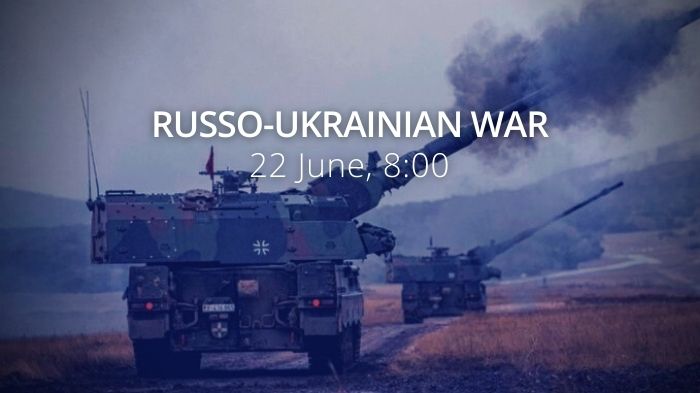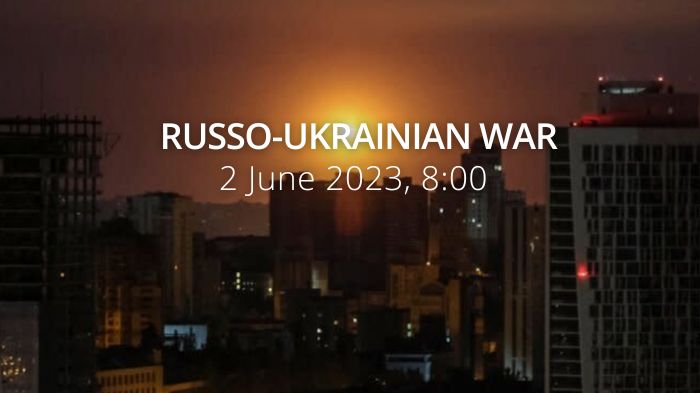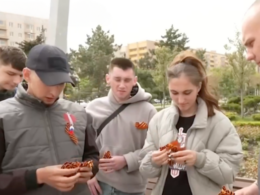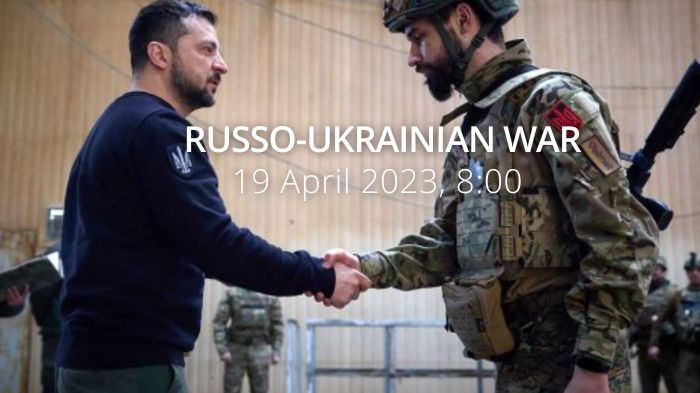Daily overview, June 21
According to information from the General Staff as of 06.00 22.06.2022, supplemented by its [18:00 assessment].
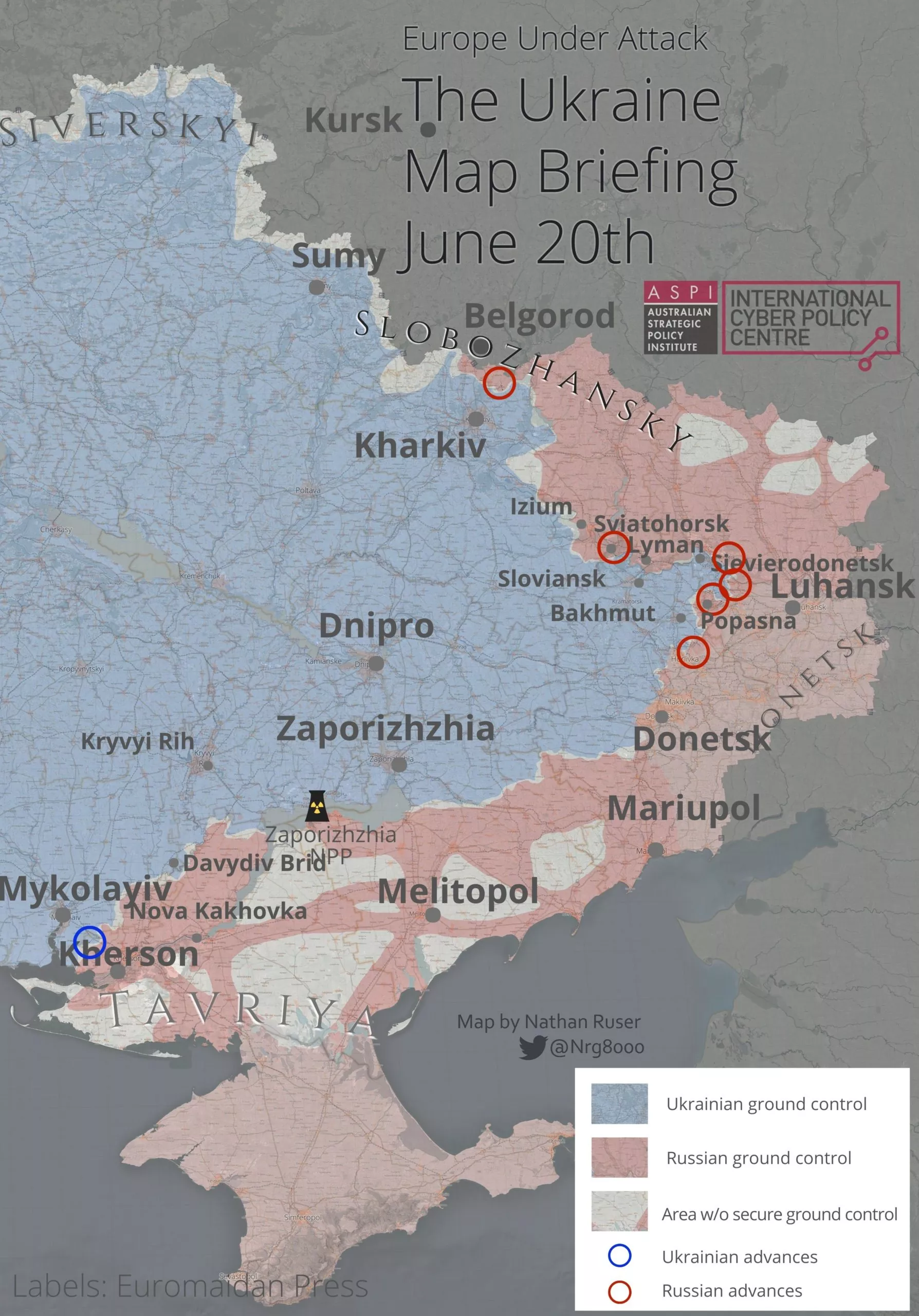
In the Volyn and Polissya directions, certain units of the Armed Forces of the Republic of Belarus focus their main efforts on conducting reconnaissance, engineering equipment of positions and protecting the state border.
In the Siversky direction, Russian forces, to demonstrate their presence, holds up to three battalion tactical groups and units of airborne troops in the border areas of Bryansk and Kursk regions. Russian forces fired mortars and artillery shells at the settlements of Seredyna-Buda, Myropillya, Sumy Oblast, and Gremyach, Chernihiv Oblast.
[In the Slobozhansky direction:]
- In the Kharkiv direction, Russian forces are conducting air reconnaissance to identify the locations of our troops. The aggressor carried out intense artillery shelling of Ukrainian positions near Kharkiv, Staryi Saltiv, Rubizhne and Chepil. In addition, Russian forces fired artillery and MLRS at civilian infrastructure in the areas of the settlements of Ukrainka, Petrivka, Shevelivka, Bazaliyivka and Prudyanka. [Yesterday, artillery shelling was recorded near Kharkiv, Peremoha, Verkhnyi Saltiv, Staryi Saltiv, Chepil, Rubizhne and Stara Hnylytsia. In addition, MLRS was used in the districts of Korobochkine, Mospanove and Kutuzivka.]
- In the Sloviansk direction, the occupiers are carrying out a systematic fire to create conditions for the resumption of the offensive on the city of Sloviansk. Conduct assault operations. They are firing from multiple rocket launchers near Nova Dmytrivka, Osynivka, Kurulka, Ivanivka and Adamivka. [Russian forces focus their main efforts on maintaining previously occupied positions and conducting defence. Yesterday, artillery shelling was recorded in the areas of the settlements of Bohorodichne, Velyka Komyshuvakha, Hrushuvakha, Dolyna, Petrivske, Zavhorodne, Protopopivka, Pryshyb, Karnaukhivka, Vernopillya, Chervone, Dovhenke and Krasnopillya. The occupiers launched an airstrike near Dibrivne.]
In the Donetsk direction, Russian forces continue to focus their efforts on the Sievierodonetsk and Bakhmut directions to reach the administrative borders of Luhansk region. [Yestrday, Russian forces fired from tanks and artillery near Sievierodonetsk, Lysychansk, Voronovo, Myrna Dolyna and Hirske.]
- [Thus, in connection with significant losses, the reorganization of two battalion tactical groups from the units of the 5th Combined Arms Army, which lost their combat capability, into one consolidated BTGr was noted. Also, according to available information, Russian forces brought units of the 1st Separate Motorized Rifle Brigade of the 1st Army Corps to restore combat capability.]
- Russian forces are trying to establish full control over the city of Sievierodonetsk, block units of the Defense Forces in the areas of Borivske and Voronove, and fighting continues.
- To strengthen their effort, Russian forces regrouped troops in the Bakhmut direction. [Yesterday, Russian forces fired on the areas of Berestove and Komyshuvakha. It led the offensive in the direction of Oleksandropil - Komyshuvakha. It was unsuccessful, and they retreated.]
- [Yesterday, the Ukrainian soldiers repulsed Russian forces' attempt to conduct reconnaissance by fighting in the directions of Metolkino-Voronovo and Metolkino-Syrotyne. Russian forces retreated.]
- [Yesterday, the occupiers were consolidating in the settlement of Ustynivka, are conducting an offensive in the direction of Bila Hora, have partial success, and hostilities continue.]
- [Yesterday, in the direction of Toshkivka - Pidlisne, Russian forces captured the settlements of Pidlisne and Myrna Dolyna, consolidated on the occupied frontiers. Also, has partial success in the area of the settlement of Hirske.]
- [Yesterday, the Ukrainian soldiers successfully repulsed the assault in the direction of Vysoke.]
- Ukrainian warriors in the direction of Myronivka - Semyhiria repulsed the assault in the direction of Vuhlehirska TPP. They also stopped the offensive in the direction of Molodizhne - Katerynivka. Russian forces retreated.
- In the Kramatorsk, Avdiivka, Novopavliv, and Zaporizhzhia directions, Russian forces are fighting to restrain the actions of units of the Defense Forces and prevent them from being transferred to threatening directions. It fired on the areas of Andriyivka, Novodonetske, Stara Ukrainka, and Huliaipole. It struck an air strike near Krasnohorivka.
In the Pivdennyy Buh direction, Russian forces are concentrating their main efforts on preventing the offensive of our troops. He did not take active action. At the same time, he fired from artillery and rocket-propelled grenade launchers in the areas of Tavriyske, Shevchenkove, Kiselivka, and Kvitneve. It struck an airstrike near Bila Krynytsia.
Russian aggressor continues to block civilian shipping. Six warships and submarines carrying Kalibr cruise missiles are operating in the Black Sea.
Strike groups of Ukrainian attack aircraft and bombers, under cover of fighters, carry out airstrikes on enemy positions. About 10 armoured fighting vehicles, enemy manpower, and several ammunition depots were destroyed. Our artillery is also successfully continuing its combat operations.”
Enemy throws all forces into capturing Luhansk region by June 26, Ukrinform reports. “Decisive fighting is underway in the Sievierodonetsk area, where Russian troops are making every effort to fulfil Putin's task and capture the entire territory of the Luhansk region by June 26. "Now, without exaggeration, the decisive fighting is underway in the Sievierodonetsk area, and Russian forces plan to fulfil the task set by its leadership, namely, to reach the frontiers of Luhansk region approximately by June 26. And now the Russian army has thrown virtually all its forces and hardware into assaulting the surrounding localities. They are trying to break through the defence of our troops and encircle the group of our troops that defends Lysychansk and Sievierodonetsk," Deputy Minister of Defence of Ukraine Hanna Maliar said.
According to her, the Armed Forces of Ukraine are fighting for every meter of Ukrainian land, destroying the forces and equipment of Russian forces, who are suffering very serious losses. "Our troops are doing everything possible to hold our territory and thwart the encirclement. But we must also understand that Russian forces have an advantage in weapons, so the situation is extremely difficult," the deputy minister said.”
Russian forces capture several more settlements in Ukraine's Luhansk region, Reuters reports. “Russian forces have captured several settlements near the embattled cities of Lysychansk and Sievierodonetsk in the Luhansk region, the regional governor and Ukraine's general staff said on Tuesday. Luhansk Governor Serhiy Gaidai told Ukraine's national broadcaster that Russian forces had captured the settlement of Toshkivka to the south of Sievierodonetsk, confirming previous reports.”
Russia captures Myrna Dolyna & Pidlisne near Lysychansk, has partial success in Hirske - GenStaff https://t.co/mtbx5cXgSj
Luhansk Governor Haidai says breakthrough happened after Russians directed 1.5 BTGs of heavy equipment to Toshkivka, captured 21 June https://t.co/lsKuqkkSA8 pic.twitter.com/Kd4FxC6DX9
— Euromaidan Press (@EuromaidanPress) June 21, 2022
Ukrainian defenders attack ''Boiko towers'' stolen by Russia in the Black Sea, Ukrainska Pravda reports. “The Armed Forces of Ukraine have hit the "Boiko towers" - drilling rigs belonging to the Russian-appropriated Chornomornaftogaz [an oil and gas company located in Simferopol, Crimea, that was "nationalised" by the Crimean authorities after the annexation of the peninsula]. " According to Aksyonov, there are injured and missing people. Patrol boats and aircraft from the Russian Defence Ministry are trying to carry out rescue operations.”
NASA's Fire Information for Resource Management System (FIRMS) shows a fire in the Black Sea south of Odesa which may be the result of one of Ukrainian morning strikes on the Russian-stolen rigs https://t.co/Ob3zRs82PS pic.twitter.com/MJONFyVD8M
— Euromaidan Press (@EuromaidanPress) June 20, 2022
Ukrainian defenders advance in the Kherson region, Ukrainska Pravda reports citing Operational Command South. Ukrainian troops are advancing in Kherson Oblast, but authorities urge Ukrainians not to report details on social media, and to wait for official reports from the military. "The actions of our troops in the southern direction, towards Kherson, are quite successful. It is very difficult for the occupiers, Nataliia Humeniuk, head of the press centre of the] Operational Command South claimed. “They have already used forces to arrange 2nd and 3rd lines of defence, they have to use extra [lines of defence], because we are already displacing Russian forces even farther from them. We are advancing...
The Armed Forces destroyed seven enemy ammunition depots in three days, Ukrainian Military Pages reported on Saturday, citing InformNapalm. “Over the past three days, at least seven facilities with significant stockpiles of ammunition have been hit by high-precision strikes in the temporarily occupied territories of Ukraine. In particular, only one warehouse in the occupied Khrustalny contained up to 1,000 tons of ammunition.
It is reported that among local residents there are rumours that the Armed Forces of Ukraine's "high-precision NATO weapons of large calibre" very accurately destroy Russian ammunition depots near Donetsk. […] InformNapalm stressed that this message is a compilation of testimonies of various insiders, which gives a rough idea of the situation and inspires cautious optimism about the beginning of the introduction of modern high-precision weapons on the front, with which the Ukrainian army.”
https://twitter.com/EuromaidanPress/status/1538863442983018498
Armed Forces of Ukraine strike Zmiinyi (Snake) Island, occupiers suffer significant losses
, Ukrainska Pravda reports. "Zmiinyi (Snake) Island has suffered an intense strike by various forces and methods of destruction, as a result, what the Ruscists proudly called the island garrison has now suffered significant losses, Serhii Bratchuk, spokesman for the head of the Odesa Oblast Military Administration, said in a video address.”
According to British Defence Intelligence, (last 48 hours):
- Heavy shelling continues as Russia pushes to envelop the Sievierodonetsk area via Izium in the north and Popasna in the south. Russia is highly likely preparing to attempt to deploy a large number of reserve units to the Donbas.
- The Russian authorities have not released the overall number of military casualties in Ukraine since 25 March. However, the self-declared Donetsk People’s Republic (DNR) publishes casualty figures for DNR forces. As of 16 June, the DNR acknowledged 2128 military personnel killed in action, and 8897 wounded, since the start of 2022. The DNR casualty rate is equivalent to around 55 per cent of its original force, which highlights the extraordinary attrition Russian and pro-Russian forces are suffering in the Donbas. It is highly likely that DNR forces are equipped with outdated weapons and equipment. On both sides, the ability to generate and deploy reserve units to the front is likely becoming increasingly critical to the outcome of the war.
- On 17 June 2022, Ukrainian forces claimed their first successful use of Western-donated Harpoon anti-ship missiles to engage Russian maritime forces. The target of the attack was almost certainly the Russian naval tug Spasatel Vasily Bekh, which was delivering weapons and personnel to Zmiinyi (Snake) Island in the north-western Black Sea.
- The destruction of the Russian vessel on a resupply mission demonstrates the difficulty Russia faces when attempting to support their forces occupying Zmiinyi (Snake) Island. This is the latest in a series of Russian vessels, including the cruiser Moskva, to be damaged or destroyed by Ukraine during the conflict.
- Ukrainian coastal defence capability has largely neutralised Russia's ability to establish sea control and project maritime force in the north-western Black Sea. This has undermined the viability of Russia's original operational design for the invasion, which involved holding the Odesa region at risk from the sea.
As of Wednesday 22 June, the approximate losses of weapons and military equipment of the Russian Armed Forces from the beginning of the war to the present day:
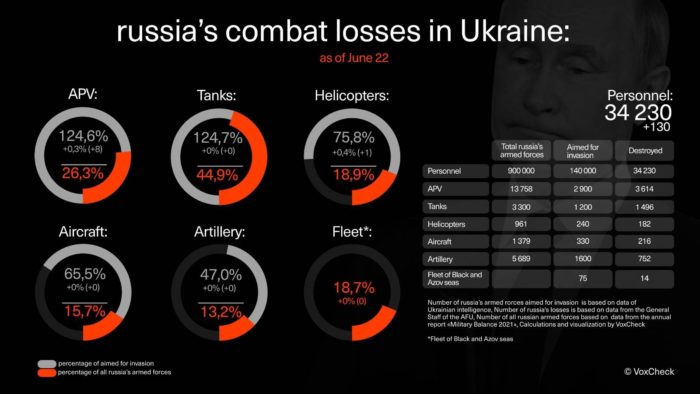
- Personnel – more than 34230 (+130),
- Tanks – 1496 (+0),
- Armoured combat vehicles – 3614 (+8),
- Artillery systems – 752 (+0),
- Multiple rocket launchers –MLRS - 239 (+0),
- Air defence means – 99 (+1),
- Aircraft - 216 (+0),
- Helicopters - 182 (+1),
- Automotive technology and fuel tanks – 2543 (+6),
- Vessels/boats - 14 (+0),
- UAV operational and tactical level – 614 (+3),
- Special equipment – 60 (+1),
- Mobile SRBM system – 4 (+0),
- Cruise missiles – 137 (+0)
Russian enemy suffered the greatest losses (of the last day) in the Sloviansk, Bahmut and Avdiivka directions.
Humanitarian
People in Mariupol are on the verge of death due to a lack of drinking water - the mayor of Mariupol, Ukrainska Pravda reports. “People living in occupied Mariupol are struggling to survive due to the lack of drinking water. Ukrainians have to queue for 4-8 hours to get water from the occupiers once a week. Vadym Boichenko, the mayor of the city, has spoken out about this, Mariupol city council reported on Telegram.
"More than 100,000 people who still remain in the city do not have access to drinking water. They are on the verge of death. This is a humanitarian catastrophe. So we have to do everything we can to open a green corridor and save people," said the mayor. Vadym Boichenko added that the Russians and collaborators have also restricted locals' access to food. The city has also been left without electricity, gas or sewerage.
Petro Andriushchenko, the adviser to the mayor of Mariupol, said that occupiers give out food only in exchange for work, and young people are threatened with mobilisation into the Russian army. The Russians have also banned the Ukrainian language, use children for propaganda [videos], are removing books from libraries and are trying to cover up their crimes in Mariupol.”
People in Mariupol are on verge of death due to a lack of drinking water - Mayor of Mariupol Vadym Boichenko
Residents have to queue for 4-8 hours to get water once a week, he said. The city is also left without electricity & gas, the city council informs https://t.co/lWKgdk7O2Y pic.twitter.com/VVWm3h5sUX
— Euromaidan Press (@EuromaidanPress) June 20, 2022
Half a million people remain under occupation in the Kherson Oblast – Lahuta, Ukrainska Pravda reports. “Hennadii Lahuta, the head of the Kherson Oblast Military Administration, said that between 450,000 and 500,000 citizens are still in the occupied territory of the region.
Lahuta said that about 50% of those who did not want to stay in the occupied area had left the area. According to him, there are currently two ways to leave the occupied Kherson region: to go to the temporarily occupied Crimea or [to go] through the occupied Melitopol-Vasylivka towards Zaporizhzhia. Lahuta also said that the Russian invaders were holding more than 600 people captive: activists, members of the anti-terrorist operation, and people who are against the occupation.
OHCHR recorded 10,308 civilian casualties in Ukraine as of June 20. 4,597 were killed (including 313 children) and 5,711 injured (including 471 children).
Environmental
Russia’s blockade of Ukrainian grain exports “war crime” - Borrell , Ukrinform reports. “Russia's efforts to block Ukraine from exporting millions of tonnes of its grain constitute a war crime, EU top diplomat Josep Borrell said June 20. "We call on Russia to deblockade the (Ukrainian - ed.) ports...It is inconceivable, one cannot imagine that millions of tonnes of wheat remain blocked in Ukraine while in the rest of the world people are suffering hunger," Borrell said, speaking to reporters in Luxembourg. "This is a real war crime, so I cannot imagine that this will last much longer," he said ahead of the EU foreign ministerial.
The war will have “dramatic” consequences for the whole world, the top diplomat stressed, voicing support for the efforts under the UN auspices to deblockade Ukrainian ports in the Black Sea and trade navigation routes in the area. Borrell also expressed confidence that the issue would be resolved in the near future. Hunger must not be used as a weapon of war, Borrell stressed, adding that energy shortage and price hikes are due precisely to Russian aggression –not the sanctions imposed by the European Union. The chief of European diplomacy underlined the fact that sanctions do not target food and fertilizer supplies so anyone willing to buy them from Russia is free to do so with no obstacles.”
Ukraine exports by land about 1.5 million tonnes of grain a month, Ukrinform resorts. "In recent months, we have exported an average of 1.5 million tonnes of grain by land – by rail and by road," Olha Trofimtseva, Ambassador-at-Large at the Ministry of Foreign Affairs of Ukraine, Coordinator of the Exporters and Investors Council, said at an online briefing on Monday, an Ukrinform correspondent reports.
She noted that European infrastructure and logistics were not ready for the amount of grain exported by Ukraine. In this context, the diplomat praised the efforts of Poland, Germany and other countries to build transit hubs on the borders, accelerated passage of trains with Ukrainian grain between countries to ports where it can be loaded on ships. She also drew attention to the fact that European partners simplified all customs and phytosanitary control procedures as much as possible so that Ukrainian grain reaches final consumers promptly.
As reported, 7 million tonnes of wheat, 14 million tonnes of corn grain, 3 million tonnes of sunflower oil, and 3 million tonnes of sunflower meal have not entered the world market due to Russia’s blockade of Ukrainian seaports. This has already led to a record rise in world market prices and will inevitably result in a global food crisis and rising inflation.
Legal
The US attorney general visits Ukraine and names a veteran prosecutor to help investigate Russian war crimes, The New York Times reports. “The United States attorney general, Merrick Garland, made a surprise trip to Ukraine on Tuesday and announced the appointment of a veteran prosecutor known for investigating former Nazis to lead American efforts in tracking Russian war criminals.
Mr. Garland’s visit to Ukraine, a previously unannounced side trip from his scheduled visits to Warsaw and Paris this week, was intended to bolster US and international efforts aimed at helping Ukraine identify, apprehend and prosecute Russians involved in war crimes and other atrocities. Mr. Garland said he was tapping Eli Rosenbaum, the former director of Department of Justice’s Office of Special Investigations, to create a new “War Crimes Accountability Team,” tasked with coordinating efforts with Ukraine and international law enforcement groups in bringing Russian perpetrators of atrocities to justice.”
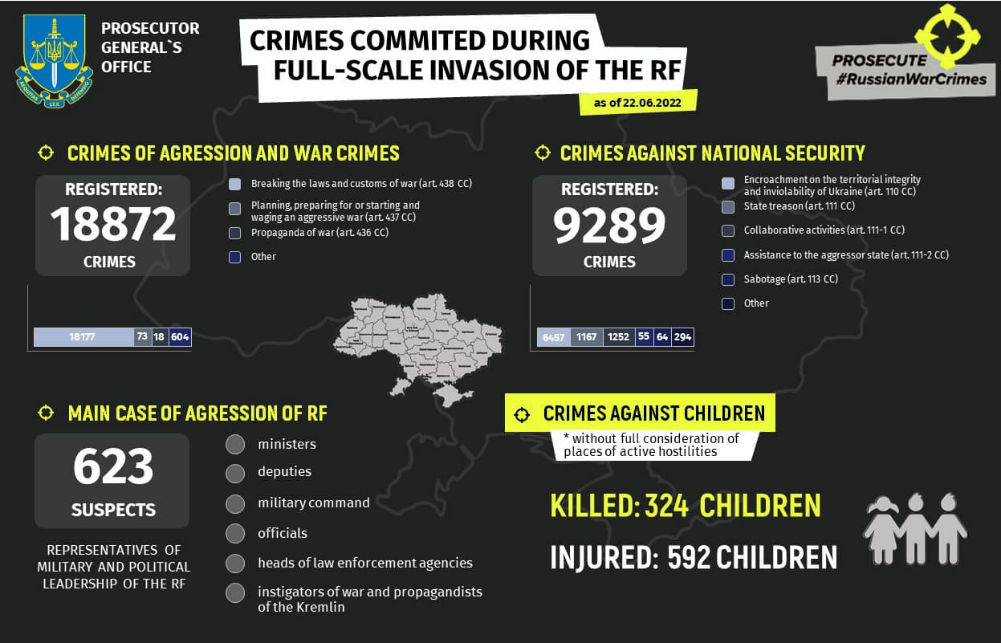 324 children were killed, and 592 children injured, the Office of the Prosecutor General of Ukraine reports as of June 22. 2,052 educational establishments are damaged as a result of shelling and bombings, 210 of them are destroyed fully. 18,872 crimes of aggression and war crimes and 9,289 crimes against national security were registered.
324 children were killed, and 592 children injured, the Office of the Prosecutor General of Ukraine reports as of June 22. 2,052 educational establishments are damaged as a result of shelling and bombings, 210 of them are destroyed fully. 18,872 crimes of aggression and war crimes and 9,289 crimes against national security were registered.
Support
Ukraine to get thousands of secure radios in latest US package, C4ISRNet reports. “The US will provide Ukraine with secure communications equipment as the Eastern European country’s fight against Russia rages into the fourth month. The US Department of Defense on June 15 said “thousands of secure radios” would be sent to Ukraine as part of a $1 billion security package announced by President Joe Biden. It gave no specifics as to models or manufacturers but described them as a “near-term priority” that would help the besieged country “defend against Russian aggression.”
The radios will be sourced using Ukraine Security Assistance Initiative funds, or USAI, and won’t come from existing US stockpiles, the Pentagon said. Instead, they will be procured from private industry, with Wednesday’s announcement kicking off the process. No delivery dates were disclosed.
Communications and connectivity are under constant assault in Ukraine, as cyberattacks hamstring websites, methods of command and control are harassed, and the telecommunications industry remains a top target.”
Howitzers arrive in Ukraine, first in pledged weapons package from Germany, Reuters reports. “German self-propelled howitzers have arrived in Ukraine in the first delivery of heavy weapons promised by Berlin, Ukraine's defence minister said on Tuesday. Ukraine has pleaded with the West to send more and better artillery as the country runs out of ammunition for its existing Soviet-era arsenal, which is dwarfed by Russia's.”
https://twitter.com/oleksiireznikov/status/1539225560588734466
New developments
- Moscow threatens Lithuania over applying E.U. sanctions to Kaliningrad, a Russian enclave, The New York Times reports. “Russia ratcheted up its confrontation with the European Union over Lithuania on Tuesday, summoning the E.U. ambassador in Moscow to protest the actions of the Baltic state, which has blocked some rail shipments to the Russian enclave of Kaliningrad. The E.U. ambassador to Moscow, Markus Ederer, and other bloc officials said that Lithuania was simply carrying out newly implemented European Union sanctions on Russia for its invasion of Ukraine.Russia’s Foreign Ministry was hardly appeased, saying that Lithuania’s actions violate the relevant legal and political obligations of the European Union and represent an escalation. We demanded the immediate restoration of normal Kaliningrad transit, the ministry said. Otherwise retaliatory measures will follow.”
- Estonia protests to Russia over airspace violation as Baltic tensions rise, Reuters reports. “Estonia summoned the Russian ambassador on Tuesday to protest an "extremely serious" violation of its airspace by a Russian helicopter, the second time in less than two weeks that Tallinn has reprimanded Moscow's envoy.”
- Putin’s office: no plans to involve Collective Security Treaty Organisation forces in the war in Ukraine, Ukrainska Pravda reports, citing Interfax. “The Kremlin said that the question of the possible involvement of the Collective Security Treaty Organisation [CSTO is an intergovernmental military alliance in Eurasia - ed.] forces in hostilities in Ukraine was not considered but stressed the importance of the CSTO for Russia.According to Dmitry Peskov, Press Secretary to the Russian president, the CSTO is of great importance; the CSTO has demonstrated its efficiency, agility and worth in the recent past." Development of the CSTO is one of our foreign policy and security priorities."
- There are no people among Ukrainian officials who allow the existence of ''Minsk-3:'' Head of the President’s Office, Ukrainska Pravda reports, citing Lb. Andrii Yermak, the head of the President's Office assured that there are no people in the governing team who would allow the "Minsk-3" option. The negotiations [with Russia] are possible only if the conditions are right… This is not about convincing someone (Putin - ed.) of something. Yes, it's about recording the current situation as it will be at that moment. And it will be absolutely clear for us. We didn’t start this war, but it is our tragedy; we have lost people; our cities have been destroyed. Therefore, there will definitely be no compromises on our part."
- Turkish team to discuss Black Sea grain corridor in Russia this week -sources, Reuters reports. “Ankara's military delegation will travel to Russia this week to discuss details of a possible safe sea corridor in the Black Sea to export Ukrainian grain, Turkish presidency sources said on Tuesday.”
- Germany risks recession as the Russian gas crisis deepens, Reuters reports. “Germany faces a certain recession if faltering Russian gas supplies stop completely, an industry body warned on Tuesday, and Italy said it would consider offering financial backing to help companies refill gas storage to avoid a deeper crisis in winter. […] Gas prices have hit record levels, driving a surge in inflation and adding to challenges for policymakers trying to haul Europe back from an economic precipice.”
Assessment
1. On the War
The Institute for the Study of War has made the following assessment as of Tuesday 21 June:
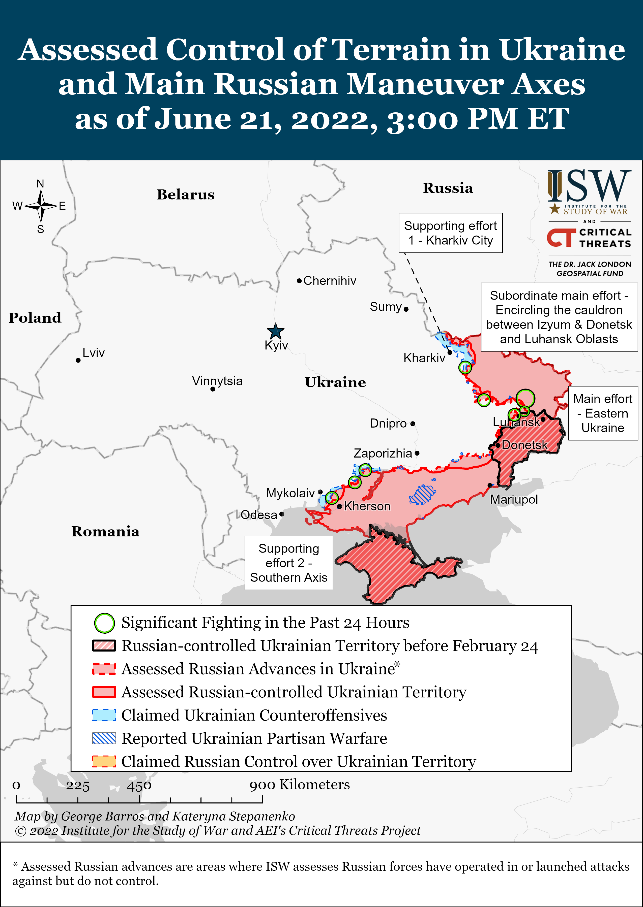 As ISW previously reported, Southern Military District Commander Dvornikov was the natural choice to command Russia’s operations in Ukraine following Russia’s loss in the Battle of Kyiv, as the majority of Russian offensive operations are occurring within the Southern Military District’s area of responsibility. The appointment of a separate commander over the Southern Military District, and the replacement of the commander of the SMD in the middle of major combat operations, is a drastic step that would speak to severe crises within the Russian high command, and possibly a purge by the Kremlin. Such drastic rotations within the Russian military, if true, are not actions taken by a force on the verge of a major success and indicate ongoing dysfunction in the Kremlin’s conduct of the war.
As ISW previously reported, Southern Military District Commander Dvornikov was the natural choice to command Russia’s operations in Ukraine following Russia’s loss in the Battle of Kyiv, as the majority of Russian offensive operations are occurring within the Southern Military District’s area of responsibility. The appointment of a separate commander over the Southern Military District, and the replacement of the commander of the SMD in the middle of major combat operations, is a drastic step that would speak to severe crises within the Russian high command, and possibly a purge by the Kremlin. Such drastic rotations within the Russian military, if true, are not actions taken by a force on the verge of a major success and indicate ongoing dysfunction in the Kremlin’s conduct of the war.
Russian forces are successfully advancing toward Lysychansk from the south rather than making an opposed river crossing from Sievierodonetsk, threatening Ukrainian defenses in the area. ISW previously forecasted that Russian forces would seek to attack toward Lysychansk from the south to negate the defensive advantage that the Siverskyi Donets River would grant Ukrainian defenders opposing a direct assault from Sievierodonetsk. Russian forces appear to be securing such an advance and will likely attack the outskirts of Lysychansk within the coming week. This Russian advance is a clear setback for Ukrainian defenses in the Sievierodonetsk-Lysychansk area, but Russian forces will likely require further protracted battles with Ukrainian forces similar to the block-by-block fighting seen in Mariupol and Sievierodonetsk in order to capture Lysychansk. […]
Russian forces continue to face force generation challenges and are committing unprepared contract servicemen to the invasion of Ukraine. The BBC’s Russian service reported on June 20 that new Russian recruits receive only 3 to 7 days of training before being sent to “the most active sectors of the front.” The BBC also reported that volunteers within the conventional Russian military, Rosgvardia units, and Wagner Group mercenaries have become Russia’s main assault force, as opposed to full conventional military units. ISW has previously assessed that Russian units in eastern Ukraine are suffering from poor complements of infantry, slowing their ability to seize urban terrain. The Russian military is offering substantial financial incentives to secure additional recruits with increasing disregard for their age, health, criminal records, and other established service qualifications. The Ukrainian General Staff reported on June 21 that Russian Airborne (VDV) units are forced to recruit reserve officers for short-term three-month contracts due to significant officer losses, and the BBC reported that the Russian Ministry of Defense is offering to pay off the loans and debts of volunteers to entice recruits.
Key Takeaways
- The Kremlin recently replaced the commander of the Russian Airborne (VDV) forces and may have fired the commander of the Southern Military District and appointed a new overall commander of Russian forces in Ukraine, indicating ongoing dysfunction in the Kremlin’s conduct of the war.
- Russian forces conducted several successful advances in settlements southeast of Sievierodonetsk on June 21 and may be able to threaten Lysychansk in the coming days while avoiding a difficult opposed crossing of the Siverskyi Donets River.
- Russian forces continued to launch assaults on settlements along the T1302 Lysychansk-Bakhmut highway to interdict Ukrainian ground lines of communications (GLOCs).
- Russian operations along the Izium-Sloviansk axis are increasingly stalled as Russian forces prioritize operations around Sievierodonetsk.
- Russian forces likely recaptured the eastern bank of the Inhulets River from the Ukrainian bridgehead situated near the Kherson-Mykolaiv Oblast border.
- Ukrainian forces reportedly struck Russian positions on Zmiinyi (Snake) Island in the Black Sea, likely to destroy Russian fortifications and equipment on the island, but ISW cannot confirm competing Ukrainian and Russian claims of the results of the attack.
- Russian occupation authorities are continuing to face challenges recruiting local collaborators and are likely relying on Russian government personnel to consolidate their societal control of occupied Ukrainian territories.“
After a Pivotal Period in Ukraine, US Officials Predict the War’s Path, The New York Times reports. As Russia makes slow but steady progress, the arrival of new weapons systems will help Ukraine hang on to territory, US officials and analysts say.
When Russia shifted its military campaign to focus on eastern Ukraine this spring, senior officials in the Biden administration said the next four to six weeks of fighting would determine the war’s eventual path. That time has passed, and officials say the picture is increasingly clear: Russia is likely to end up with more territory, they said, but neither side will gain full control of the region as a depleted Russian military faces an opponent armed with increasingly sophisticated weapons.
While Russia has seized territory in the easternmost region of Luhansk, its progress has been plodding. Meanwhile, the arrival of American long-range artillery systems, and Ukrainians trained on how to use them, should help Ukraine in the battles to come, said Gen. Mark A. Milley, the chairman of the Joint Chiefs of Staff. […] Pentagon officials said that meant Russia might not be able to make similar gains in neighboring Donetsk, which along with Luhansk forms the mineral-rich region of Donbas. […]
After weeks of bloody battles in the east — with as many as 200 Ukrainian soldiers killed daily, by the government’s own estimate, and a similar or higher toll among Russian troops, according to Western estimates — Russia holds roughly the same amount of territory in Donetsk as the separatists controlled in February before the invasion.
But US officials say they expect Russia to soon take over the entire Luhansk region
. One defense official said he anticipated that the twin cities of Sievierodonetsk and Lysychansk would fall in days, as Russian forces pounded the area with heavy artillery and “dumb bombs” — unguided munitions that inflict high casualties.
According to reports over the weekend, Russian forces had broken through the Ukrainian front line in Toshkivka, a town just outside Sievierodonetsk and Lysychansk. Seizing Toshkivka would put the Russians closer to being able to threaten Ukrainian supply lines to the two cities, the last major population centers in Luhansk that have not fallen to Russia. […]
Russian ground troops have advanced slowly, in some cases taking weeks to move one or two miles, US officials said. That might signal a lack of infantry soldiers or extra caution by Moscow after it experienced supply line problems in its disastrous first weeks of the war.
Several military analysts say Russia is at peak combat effectiveness in the east, as long-range artillery systems promised to Ukraine from NATO countries are still trickling in. Ukraine is hugely outgunned […] President Biden on Wednesday announced an additional $1 billion in weapons and aid for Ukraine, in a package that includes more long-range artillery, anti-ship missile launchers, and rounds for howitzers and for the new American rocket system. […]
Defense Secretary Lloyd J. Austin III urged Western allies last week to redouble their military aid to Ukraine, warning that the country “is facing a pivotal moment on the battlefield” in its nearly four-month fight with Russia. Mr. Austin and General Milley met with US allies in Brussels to discuss how to further help Ukraine. Pentagon officials expect that the arrival of more long-range artillery systems will change the battlefield in Donetsk, if not in Luhansk.
Frederick B. Hodges, a former top US Army commander in Europe who is now with the Center for European Policy Analysis, said the war would probably last many more months. But he predicted that Ukraine’s forces — bolstered by heavy artillery from the West — would slow Russia’s advance and begin to roll back its gains by late summer. “War is a test of will, and the Ukrainians have superior will,” General Hodges said. “I see the Ukrainian logistical situation getting better each week while the Russian logistical situation will slowly degrade. They have no allies or friends.”
Russia’s military is built for short, high-intensity campaigns defined by a heavy use of artillery, military analysts said. It is not prepared for a sustained occupation, or the kind of grinding war of attrition underway in eastern Ukraine that requires swapping out battered ground forces. “This is a critical period for both sides,” said Michael Kofman, the director of Russian studies at C.N.A., a research institute in Arlington, Va. “Probably in the next two months, both forces will be exhausted. Ukraine has a deficit of equipment and ammunition. Russia has already lost a lot of its combat power, and its force is not well suited for a sustained ground war of this scale and duration.”
Russia will try to continue making mile-by-mile territorial gains, and then will probably harden its front lines with mines and other defenses against a Ukrainian counterattack, which is expected after the long-range artillery systems arrive on the battlefield, analysts said. […]
Even though terrain could change hands, “neither side has the mass to exploit minor gains,” Christopher M. Dougherty, a former Army Ranger and a defense analyst at the Center for a New American Security, said in a Twitter post this month. “The war now likely becomes a test of endurance.” As a result, several military analysts said, Moscow and Kyiv will both rush reinforcements to the front lines.
“The race to resupply will be critical for both sides,” Col. John B. Barranco of the Marine Corps, Col. Benjamin G. Johnson of the Army and Lt. Col. Tyson Wetzel of the Air Force wrote in an Atlantic Council analysis. “To replace its losses, the Kremlin may need to resort to sending in thousands more conscripts,” the officers said, adding that Ukraine will need to maintain its logistics lines and move forward ground-based weapons, including long-range artillery and unmanned aerial systems.
Analysts and former US commanders offered differing forecasts on how the war might change.
Weaknesses in the Ukrainian military’s position are beginning to show — and are sowing concern. While some independent analysts have predicted that the Russian advance will be halted in Sievierodonetsk, US government experts are not so sure. Some say they believe that the grinding Russian advance could continue and that the Russians could soon make more progress in areas where Ukrainian counterattacks have been successful.
The tactics Russia is using, according to current and former officials, are having a devastating effect in eastern Ukraine, wreaking so much destruction that Mr. Zelensky has said troops are fighting over “dead cities” where most civilians have fled.
Other analysts predict a back and forth that could stretch for months or even years. “This is likely to keep going, with each side trading territory on the margins,” Mr. Kofman said. “It’s going to be a dynamic situation. There are unlikely to be significant collapses or major surrenders.”
Military and intelligence officials said Russia had continued to suffer severe losses and was struggling to recruit soldiers to refill its ranks. Morale is low in the Russian military, and problems with poorly maintained equipment persist, US officials and analysts say.
The fight in the Donbas has become a deadly artillery duel that is inflicting heavy casualties on both sides. Commercial satellite imagery of craters in eastern Ukraine suggests that Russian artillery shells are often exploding on the ground near Ukrainian trenches, not in the air above them. Airburst artillery kills soldiers in trenches more effectively. Stephen Biddle, a military expert and professor of international relations at Columbia University, said the imagery suggested that the Russians were using old ammunition that had been poorly maintained. But inefficient artillery can still be very destructive when employed en masse. “Quantity has a quality all its own,” Dr. Biddle said.”
2. Consequences and what to do?
Hans Petter Midttun: All eyes are fixed on the situation on the ground, and in the east in particular.
Let's imagine for a moment that the war is all about territorial gains and that everything else Russia do is in support of this aim. If we did, we are left with the impression of a botched “Blitzkrieg”, turned into a war of attrition dominated by massive usage of MLRS, artillery, and mortars. We are mesmerised by the Russian atrocities against civilians both in occupied territories as well as through its indiscriminate bombing and shelling of cities and villages. After four months of fighting, the frontline has moved by inches rather than miles. Neither Ukraine nor Russia has the forces needed to exploit minor gains. While Russia has been making slow, grinding progress since it refocused its efforts on Donbas, some believe that this will come to a halt once the western weapons start arriving in volume. Many analysts predict a protracted war lasting years.
That is, however, only partly true. The ground situation and amount of territory Russia manage to occupy will have an impact on the outcome of the war, no doubt. Its ability to obliterate or weaken the Ukrainian Armed Forces is of equal importance. But so is the effect of the war on Ukraine’s will to fight, the financial stability and viability of the state, Ukraine's ability to provide its citizens with basic services (e.g. electricity, water, health, etc), and the Western resilience and its will to both support Ukraine and confront Russia.
The single-minded focus on territorial gains does not define the Russian strategy. Since 2014, the strategy has focused on the use of both military and non-military means to undermine Ukrainian statehood. While the balance and importance of the various means have shifted over time, the Russian approach has always been comprehensive. An effective counter-strategy must be equally broad. Long-range weapon support – combat aircraft, UAV, MLRS, artillery and cruise missiles – is crucial alongside all the other means needed to ensure Ukraine remain a strong, well-functioning democratic country.
Russia is employing its Black Sea Fleet with a very different objective than ensuring “territorial gains”. It is deployed to break the Ukrainian economy and blackmail the West into submission. Like all other maritime states, Ukraine’s economy and, therefore, its independence and sovereignty are interlinked with its maritime exports and imports. Global food security and the consequences of lack of thereof will challenge political stability across the USA, Europe, the Middle East and Africa.
The West has always been a party to the war. Russia has been waging a hybrid war against the USA and Europe for more than a decade already. It has given both NATO and the USA an ultimatum, telling the West to withdraw NATO infrastructure and military forces from central and eastern Europe, stop operating in areas or airspace within striking distance of targets in Russia, and stop further eastward expansion. It has not least, waged wars in other countries, including Moldova, Georgia, and Syria to make military power an integrated part of its increasingly more aggressive foreign policy. Its militarization of the Arctic is a part of its more assertive policy. Its comprehensive approach, combined with the war in Ukraine allows Russia to trigger a “tsunami of ripple effects” that target Western resilience and its unity to effectively meet the Russian confrontation.
The West desperately needs a robust strategy to force Russia to sit up and pay attention. It must be so much broader than the present approach and must include a clearly defined end-state and objectives. It should both outline what a Western and Ukrainian victory looks like and the desired timeline that achieves both. If we lack resilience – if we are concerned about the “tsunami of ripple effects” from the war - it is crucial to define the active measures needed to change the timeline in our favor.

